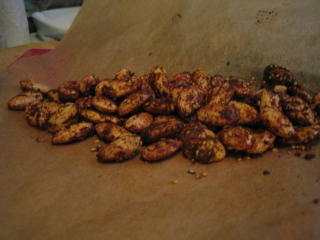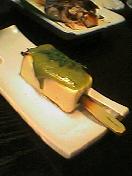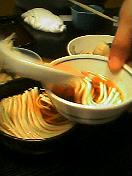Lemon Polenta Cake

Sometimes getting up at 6 am on a Saturday morning can be good for your health. Blancs has been working the last few Saturdays, so I “decided” that I “wanted” to help out last weekend. We started by doing the shopping for the day. I was mildly disturbed to hear the local supermarket lady say how she “always thought Blanca was a señorita… what a surprise; you’re a señora!”. I don’t want to know why she thought Blancs was a señorita. The stall owners in Notting Hill now call me “Blanca’s little helper” or probably “sucker”… I’m trying to decide which I prefer.
This was my first time in a professional kitchen (I hope that Blanca’s boss never reads this blog). I was on Lemon Polenta duty. This is in the Books for Cooks cookbook volume 1,2 & 3. It is originally from the River Cafe Book 1.
Lemon Polenta Cake
250 g soft butter
250 g caster sugar (granulated)
Zest of 2 lemons
250 g ground almonds
1 tsp vanilla essence
3 eggs
Juice of 1 lemon
125 g polenta
1 tsp baking powder
Pinch of salt
Beat butter, sugar and zest until fluffy (and almost white). Stir in almonds and vanilla. Add eggs one at a time, beating each before adding the next. Fold in lemon juice, polenta, backing powder and salt. Spoon the mixture into a buttered cake tin.
Bake in a 160 c oven until sides pull slightly from the edges of the tin. This should take approximately 50 minutes. The cake is cooked when it feels firm and springs back from placing your hand on it.
The science...
Of course, I was acting as a professional, which apparently doesn’t mean that I get paid, it means that I just do things when I’m told and how I’m told… I’m not even Blanca’s “little helper”; I’m her bitch.
Nevertheless, I did have some questions going through my head:
- why use soft butter?
- why use caster sugar?
- why add the eggs one at a time?
- what is fold?
- why fold?
- when can I go back to bed?
I left Books for Cooks as the morning rush started (talk about too hot in the kitchen). When I got home I did some investigations in the Leith’s Techniques Bible. As far as I can see, this method of backing is called the “creaming method” (mainly because it doesn’t involve the use of cream… oh, the irony). This is the method used in making simple sponge cakes. There are 3 steps to the creaming method…
Why do we need to use soft butter and caster sugar?
- Step 1: Cream the butter and sugar. This incorporates air to enable the cake to rise. Some of the sugar does not dissolve, but rather is held in suspension and therefore stabilises the mixture. Caster sugar is the best sized crystals in order to be suspended / support the egg yet retain their invisibility.
Why do we need room temperature eggs and why do we need to add them one at a time?
- Step 2: Room temperature eggs are added (colder eggs can cause the butter to cool and separate into clumps… i.e. curdling). As the mixture is beaten, the egg proteins stretch, holding air bubbles within itself. If the eggs are added to quickly, it can cause the mixture to… guess what; curdle.
Why do I fold.. eh, how do I fold?
- Step 3: Flour is folded into the mixture. This is to ensure that the air is not simply “stirred out”. A large metal spoon with a sharp edge is best (it cuts easily through the mixture). “Cut” the spoon in to the center of the mixture down to the bottom, draw a scoop of batter towards you, bring it up the side of the bowl, lift and turn the spoon to flip the mixture over, rotate the bowl ¼ and repeat. This is called the figure-eight method – chiefly because it looks nothing like a figure of eight. Don’t overfold as this can knock the air out and allow gluten to develop in the flour, making the cake tough.
I thought polenta was an Italian meal – why am I adding it into a cake?
Polenta is a fine ground cornmeal principally used in Italian cooking. When warm it has a soft texture like potato and is regularly eaten as a starchy accompaniment to meats. It is frequently eaten cold (when it has a firm texture) or fried. As I may have mentioned above, it can also be used in cakes as flour.
DAMNIT… now I need to do a blog on flours.














